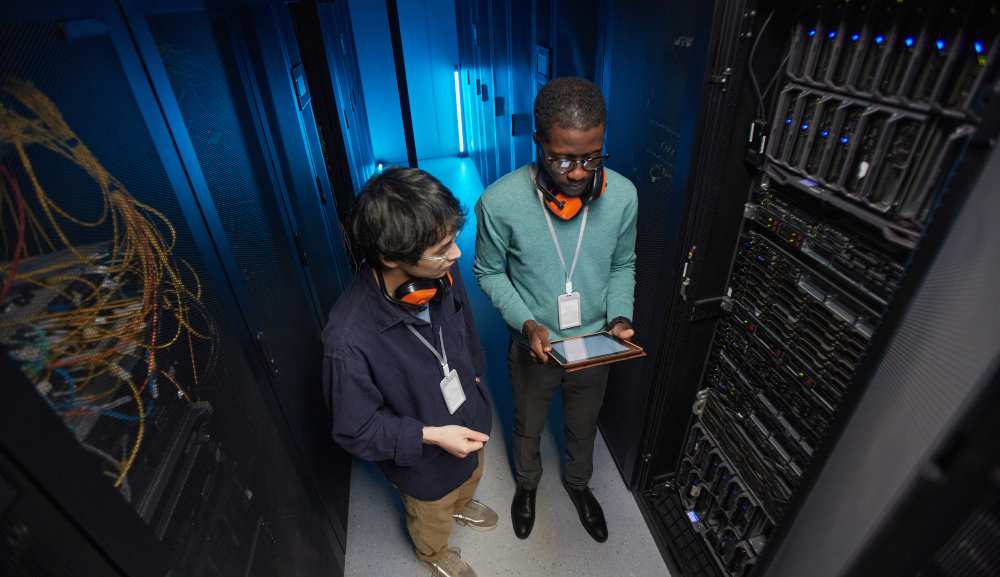How Does Virtualization Help with Disaster Recovery within a Data Center?

Data center virtualization simplifies disaster recovery, offering faster backups, automation, and resilience through cloud computing.
Especially in the disaster recovery, data center virtualization has grown to be a pillar of current IT policies. Virtualization helps companies to more safely and effectively control on their IT infrastructure by abstracting actual resources and converting them into virtual versions. With special focus on its importance in cloud computing, automation, and regional settings like the increasing usage of data centers in Cambodia, this paper investigates how virtualization helps disaster recovery in a data center.
Understanding Data Center Virtualization

Data center virtualization is the creation of virtual copies of physical objects such as servers, storage, and also networks. Use virtualization technologies, a virtual data center replics physical infrastructure inside a software-defined environment. This abstraction improves flexibility, lowers reliance on real hardware, and lets advanced features like scalability and automation run free.
Organizations might maximize operations, lower costs, and strengthen disaster recovery systems by using virtualization for data center automation. Virtualization for data center automation in cloud computing, in particular, offers a dynamic and flexible way to manage IT resources while ensuring business continuity during crises.
The Role of Virtualization in Disaster Recovery
Data center operations depend critically on disaster recovery (DR), which guarantees that companies may quickly recover from unexpected events, like hardware failures, cyberattacks, or natural disasters. Virtualization has these advantages that quickly improve disaster recovery:
- Simplified Backup and Replication
Backing up and replicating virtual machines (VMs) is way easier than physical systems. In virtualization for data center in cloud computing, companies can generate snapshots of virtual machines and save them in several sites; this guarantees data redundancy. This feature guarantees that important systems may be rapidly rebuilt from another site even if one becomes unavailable.
- Faster Recovery Time
Restoring a physical server might be labour-intensive in conventional disaster recovery plans. Data center virtualization lets whole virtual environments be rebuilt in minutes, hence minimizing downtime. Virtualization of cluster and data centers in cloud computing enables seamless failover to backup systems, ensuring uninterrupted operations.
- Hardware Independence
Hardware-agnostic virtualized environments run on any supported hardware, independent of brand or configuration. This adaptability helps companies to more wisely employ their resources during disaster recovery, therefore preventing delays brought on by hardware compatibility problems.
- Cost Efficiency
Virtual data centers help to reduce the demand for duplicate physical infrastructure required in disaster recovery. By combining redundant gear, virtualization for data center automation helps businesses reduce maintenance costs and expedite task.
- Testing and Validation
Data center virtualization lets companies test disaster recovery strategies in a controlled environment free from interfering with active systems. A virtualized data center in Cambodia, for instance, might replicate crisis scenarios to evaluate recovery plans and therefore assure preparation should an actual disaster strike.
Virtualization and Cloud Computing: Key Differences and Synergies
What is the difference between the functions of cloud computing and virtualization? Though they have different uses and complement one another, many people mix virtualization with cloud computing. Whereas cloud computing offers scalable, on-demand access to shared resources over the internet, virtualization generates virtual versions of actual resources. When combined, virtualization for data center in cloud computing unlocks powerful disaster recovery capabilities.
Key Differences Between Virtualization and Cloud Computing
- Functionality: While cloud computing emphasizes virtual instances as a service, virtualization is more concerned with building virtual instances.
- Scope: Whereas cloud computing is a service paradigm, virtualization is a technology.
- Usage: While cloud computing lets companies access outside infrastructure, virtualization is commonly utilized to maximize in-house data centers.
How Virtualization Enhances Cloud-Based Disaster Recovery
Virtualization of clusters and data centers in cloud computing enables businesses to extend their disaster recovery plans into the cloud. Replacing virtual computers with cloud-based systems gives companies access to regionally scattered resources and strengthens their resistance against localised calamities.
Data Center Virtualization Automation
Modern data centers mostly depend on automation, and virtualization is a main tool for enabling this change. By automating regular processes, including provisioning, monitoring, and scaling, virtualization for data center automation releives resources for strategic activities.
Key Benefits of Automation Through Virtualization
- Rapid Provisioning: Quick deployment of virtual machines allows one to satisfy evolving needs.
- Resource Optimization: Automated load balancing guarantees the best possible hardware resource use.
- Enhanced Security: Automation ensures consistent execution of security requirements among virtual environments, hence decreasing vulnerabilities during disaster recovery.
A virtualized data center using cloud computing's data center automation may decrease downtime by automating the workload movement following a power outage.
The Importance of Virtualization Data Center Industry
Driven by the demand for a strong IT infrastructure and growing digitization, the data center business is growing. Datacenter virtualization is absolutely necessary for developing nations like Cambodia tackling limited physical space, great expenses, and demand for scalable solutions.
Datacenter virtualization helps companies in Cambodia to accomplish the following:
- Efficient Space Utilization: By reducing the demand for actual servers, virtualization helps to save space and lower running expenses.
- Scalability: Perfect for the digital economy, a virtual data center can rapidly increase resources to satisfy rising needs.
- Enhanced Disaster Recovery: virtualized environments let companies apply dependable and reasonably priced disaster recovery strategies.
The integration of virtualization for data center in cloud computing will be essential for ensuring robust and flexible IT operations.
Virtualization of Clusters and Data Centers in Cloud Computing
Modern data centers depend critically on clusters since they allow scalability and great availability. Virtualization of clusters and data centers in cloud computing combines the power of clustering with the flexibility of virtualization, creating resilient and efficient infrastructures.
Key Advantages of Cluster Virtualization
- Load Balancing: Virtualizing lets jobs be dynamically distributed among clusters, therefore maximizing performance and preventing congestion.
- High Availability: Virtualized clusters automatically migrate work in case of node failures, therefore guaranteeing constant availability.
- Simplified Management: Centralized management tools allow IT teams to monitor and control virtualized clusters more effectively.
For disaster recovery, especially, this method is quite helpful since workloads can be readily moved between clusters to guarantee business continuity.
Conclusion
Through shorter recovery times, better resource use, and increased flexibility, virtualization has transformed disaster recovery inside data centers. Virtualization provides scalable and reasonably priced solutions to meet the needs of disaster recovery, whether they are for a large worldwide company or a growing market participant like a data center in Cambodia.
The synergy between virtualization for data center automation in cloud computing will continue to define the future of IT as data centers adopt automation and cloud computing. Using virtualization of cluster and data centers in cloud computing, companies can create strong infrastructure able to endure unanticipated events. Ultimately, virtualization and cloud computing help companies to flourish in an always shifting digital terrain in addition to supporting disaster recovery.
Read More: What is Virtual Workspace and How it is Beneficial to Reduce Employer Budget?
More Articles
 12 Dec 2025
12 Dec 2025
Top Programming Languages to Learn in 2026
Updated overview of top programming languages to learn in 2026 focused on growth potential, developer pathways, industry needs and real applications.
 11 Dec 2025
11 Dec 2025
Deep Learning Video Editing: AI-Powered Post-Production
Deep learning video editing brings advanced automation and AI precision to modern post-production, giving creators smoother, smarter ways to shape video content.
 10 Dec 2025
10 Dec 2025
Latest Freelancing Trends in Technology for Remote Work
Stay ahead in remote work with insights on Freelancing trends in technology, top skills and global technology freelance opportunities.
 10 Dec 2025
10 Dec 2025
Cloud Disaster Recovery Planning for Business Continuity
Cloud Disaster Recovery Planning helps businesses stay resilient with clear strategies that reduce downtime and protect critical operations.